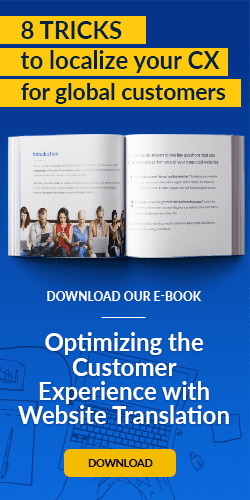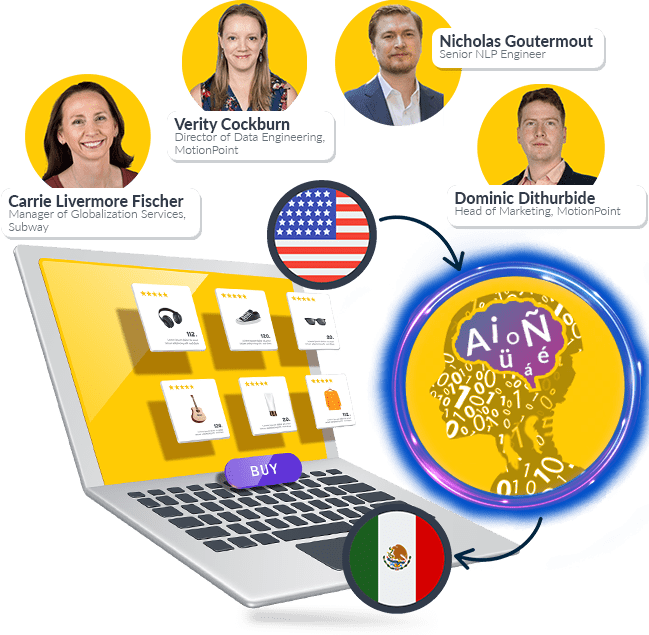To create authentic and persuasive connections with your online global customers, your website should feature localizations and customizations—special translated content crafted exclusively for customers in international markets. This creates trust and credibility.
MotionPoint's fully turn-key website translation solution tackles the technical and linguistic challenges associated with implementing this highly-targeted content. We do this far better than an in-house approach, or other vendors with undercooked technologies.
Read on to learn more about our unique approach.
The Difference Between Translation and Localisation
Let’s first set a baseline by identifying these terms:
Translation: The simple converting of one word or concept into its equivalent in another language. The translations are understandable by anyone who speaks the language.
Localisation: A more nuanced approach, these translations reflect the unique personality and culture of the market. This authentic content feels like it was crafted by a local. It resonates with customers in a way conventional translation does not.
Localisation: Fluency in Brands and Local Markets
The ability to “speak like a native” in global markets can mean the difference between wooing local customers and falling into brand obscurity.
This includes not just knowing what words mean, but the awareness and ability to accurately leverage unique local phrases, references and other cultural knowledge. These are things less-qualified translation vendors and machine translation always miss. Only with such attention to detail can your brand adequately and accurately position itself in a new market.
Localisation generates far more customer goodwill and trust than conventional translation alone.
MotionPoint excels at adhering to your brand style guides and adapting them to local markets. Our ability to craft localised translations hails from our linguists, who are native speakers-and who are required to regularly travel to their home countries to stay sharp on local lingo and cultural changes that might affect translations.
There are additional benefits to localizations, including in-market SEO. By publishing authentic translations that reflect the local culture, your website is more likely to rank in local search. Why? Your on-site content matches the unique words people in that market are using in regional search engines.
Customisation: Unique Online Content and Experiences
Customizations are different from localizations. They involve changing elements of your translated site to accommodate the needs of local customers. These changes can range from publishing market-specific promotions, highlighting particular product lines, or even categories of products (to accommodate for geographic needs, including seasonality), and more.
This is where MotionPoint's technology comes into play. Our system can customise numerous elements of your website, depending on the needs and conditions of your target markets. Those changes can be applied and displayed dynamically, depending on the geographic location of the website visitor.
Customizations provide powerful ways to engage customers, by presenting market-specific content, local promotions and more.
You Need Technical Expertise, Too
Implementing localizations and customizations also requires fluency in translation technology. MotionPoint uses special tech and tools to streamline the content customisation process. We do this in two key ways:
In-Context Translations
MotionPoint’s linguists use special technologies that enable them to see a “live view” of how their translations will appear on the webpage they’re translating.
This contextual integrity helps linguists modify lengthy translations that might break webpage templates. Further, without this critical visibility into the entire webpage, linguists are at risk of “translating in a vacuum”—merely translating scraps of paragraphs or product descriptions, with no understanding of how they interrelate on the assembled webpage.
Effective Use of a Translation Glossary
A translation glossary is a resource MotionPoint’s linguists and our customers collaborate on before a website translation project begins. The goal of this linguistic rulebook is to identify industry-specific terms, as well as a brand's localised voice and tone.
Throughout the translation process-at launch and on-going-MotionPoint's linguists refer to this glossary to best represent your industry, and perfectly replicate your brand's personality, consistently, in other languages.
MotionPoint’s Process Expertise
MotionPoint's translation processes are also designed to optimise the quality of our localizations and customizations. Here's how.
A dedicated team: MotionPoint provides its customers with a dedicated translation team, assigned to their project from day one. These linguists localize your website, day in and out. They’re on call for urgent tasks, too.
Translator qualifications: MotionPoint linguists and editors are rigorously vetted; less than 10% of applicants pass our linguistic requirements, and even fewer are hired. They are native speakers of the languages in which they’re translating, and experts in your industry and its terminology.
Cost-Saving Efficiencies: MotionPoint also uses an exclusive technology called Translation Memory Sequencing to deploy websites at a fraction of the cost of translating them from scratch. This saves at least 40% on costs by smartly repurposing translated content from global markets you’re already serving.
How MotionPoint Makes It Easy
MotionPoint’s fully turn-key solution works because it operates independently of your website’s CMS and the rest of your technology stack.
Our proxy technology uses your code to quickly create localised instances of your website targeting multiple markets, taking as much off your plate as possible.
There are other approaches you could consider when planning a website translation, localisation or customisation project. But thanks to its industry-leading combination of language fluency, cultural awareness and technical expertise, MotionPoint's hassle-free solution is the only one worth choosing.
Last updated on October 03, 2017

